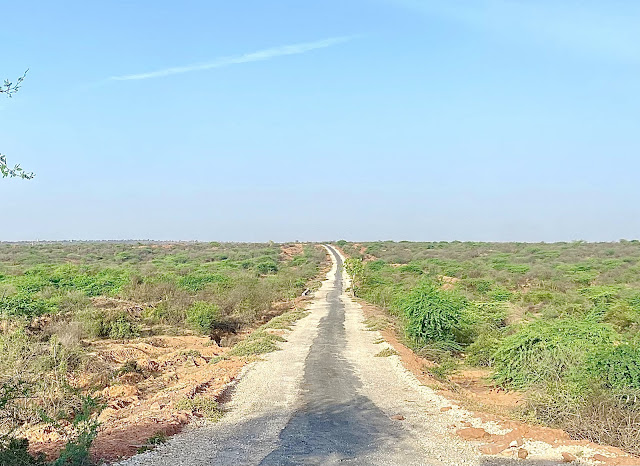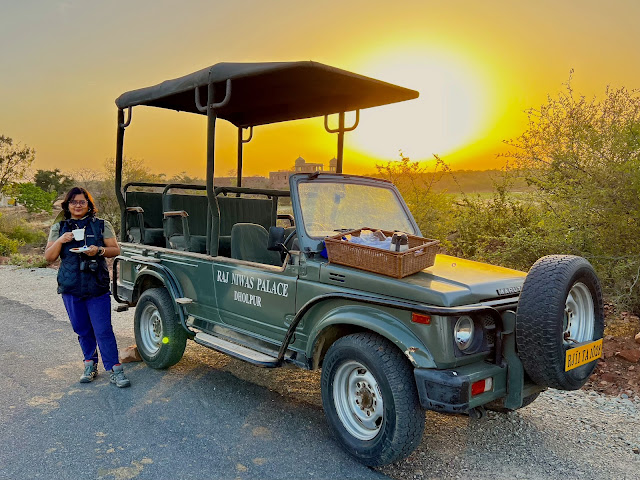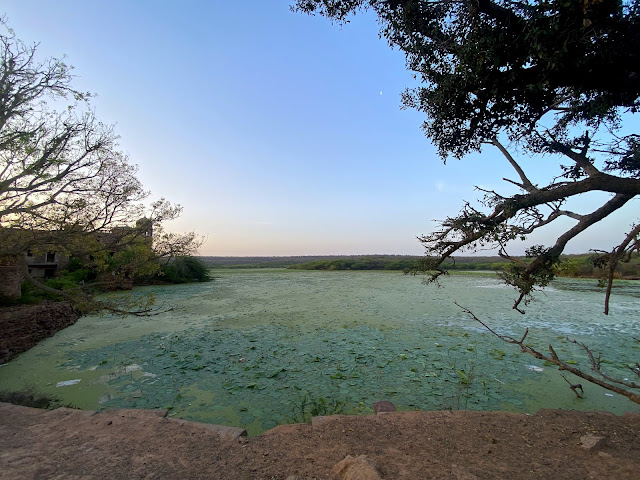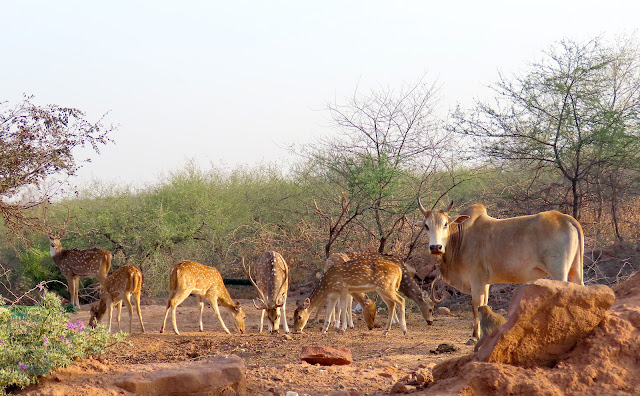 |
| At Van Vihar Sanctuary, Rajasthan. Image credit: Arijit Nag |
I woke up to the songs of the birds. I checked the clock. It was just 5:30 am. I had set the alarm to 6 am, but I guess my excitement could not wait any longer. It took me just half an hour to get ready. By that time, my husband had woken up too. Soon, we were ready with our backpacks for the day. As we opened the doors of our villa at the Raj Niwas Palace, Dholpur, we were greeted by the ethereal sight of the gorgeous peacocks that populate the grounds and gardens of the palace. Outside in the parking lot, our vehicle for the day, a grand-looking open jeep, was waiting with the driver and the guide. Soon, we were off to explore a little-known destination - the Van Vihar Sanctuary of Rajasthan.
Our jeep sped through the small town of Dholpur in Rajasthan. People were already out on the streets. Here, life starts early in the day. Everyone's eyes were on our open jeep. It is not something they see every day. We felt like celebrities taking a ride and staying in a palace-turned-heritage hotel in the town. It was all a grand experience.
Around forty minutes from Dholpur town, we reached our destination. I had expected a proper gate announcing the entry to the sanctuary or at least a signboard, but there was nothing of that sort. Only our guide's declaration that we were in the sanctuary is what let us know that it was the Van Vihar Sanctuary. Do not mix it up with the Van Vihar National Park, which is a destination near Bhopal, Madhya Pradesh.
 |
| The road through the Van Vihar Sanctuary, Rajasthan. Image credit: Oishimaya Sen Nag |
On both sides of the metalled road was raw wilderness. Sprawling scrub jungles and grasslands spread out on either side. In the distance, I could see the ruins of an ancient building. Our guide explained that it was the former forest rest house of the rulers of the past, the same dynasty that owned the Raj Niwas Palace where we were staying.
We got out of our jeep and onto the main road. There were hardly any vehicles or any other soul out there. We were served morning tea and cookies. It was indeed a pleasant experience to sip tea in the calm environment of the sanctuary while watching the sun rising above the ancient ruins and listening to the bird calls.
 |
| At Van Vihar Sanctuary, Rajasthan. Image credit: Arijit Nag |
Once done, our guide asked us if we wished to explore the ancient rest house. Of course, we were more than ready. We decided to walk there instead of riding the vehicle. First, we came across a massive lake to our right, suffering from eutrophication. Opposite the lake on the other side of the road was a Hanuman temple with some men from the local Gujjar community performing some rituals inside.
 |
| The waterbody inside the Van Vihar Sanctuary. Image credit: Oishimaya Sen Nag |
What really caught my eye was a board outside the temple warning people of mugger crocodiles in the lake. The calm, harmless-looking water body suddenly appeared more alive to me. Somewhere out there in the waters, muggers are lurking around. No wonder the board was put up. If anyone entered the waters without knowing, they might not come out of it again!
 |
| Sign on the side of the temple warning about the presence of mugger crocodiles in the lake. Image credit: Oishimaya Sen Nag |
Just a few steps later, another sight greeted us, and this one was truly magical. To our left was a large herd of chital or spotted deer. Handsome males with branching antlers, beautiful-eyed females, and adorable small ones were all on the alert, trying to measure our next move and assess if we were threats of any kind. However, given that they are wild deer, it was quite surprising to see them being so bold and not running away immediately upon seeing us, unlike in other forests. I came to know the reason for this while on our way back.
 |
| Spotted deer herd in Van Vihar Sanctuary. Image credit: Oishimaya Sen Nag |
On the opposite side of this enchanting scene was the old forest mansion called the Van Vihar Kothi. On the outer gate of the mansion, there was a signboard that read, "Hunting panthers and bears in this sanctuary is strictly prohibited." That was the first time when we actually saw something written about the sanctuary's existence. We also got to know about some of its most coveted inhabitants - leopards and sloth bears. Our guide also informed us that the sanctuary is home to sambars, nilgais, hyenas, wild boars, and many bird and reptilian species as well.
As we entered the grounds of the mansion, we could feel its past grandeur. However, inside, it was all in ruins. Giant cobwebs hung on the walls and ceilings, and the floors were all carpeted with bird poop. I was quite disappointed to see history falling apart.
 |
| The entry gate to the Van Vihar Kothi. Image credit: Oishimaya Sen Nag |
I heard from the guide that a feud between the local community and the ex-royals who own the property had prevented the building from being renovated. Plans were to convert it to a hotel in the wilderness. Given the excellent location, I could see that it would make a fantastic one. Also, the guide informed us that there were plans to relocate some tigers from Ranthambhore's growing tiger population to this sanctuary, which would mean tourists pouring into the area.
We went up the stairs to the terrace. What a spectacular view from there! The water body spread out on one side, and the wilderness expanded beyond it and in all other directions.
 |
| On the terrace of the Van Vihar Sanctuary. Image credit: Arijit Nag. |
We could see that people do come up to the terrace as there were bananas laid out in a series for the visiting monkeys. Evidence was also right there in front of us as we saw a curious rhesus macaque happily feasting on a banana along the ledge of the terrace. On a tree by the water body, I also got to see beautiful rock pigeons and rose-ringed parakeets, making for a very pretty sight.
As we exited the mansion, we saw something totally unexpected. There were people feeding, throwing grains and biscuits all around, and deer, cows, monkeys, and birds all gathered in one place to make the best of this opportunity of ready-made food.
 |
| Spotted deer, rhesus macaque (in front of the cow), and domestic cow, all in one place. Image credit: Oishimaya Sen Nag |
The conservation thinker in me knew that this was totally not the right thing to do. Humans must not feed wild animals except in cases where the animal is under treatment or has been rescued from some mishap. Feeding makes them dependent on humans for food. Often, the food given by humans is also not good for the health of these animals. Also, bringing wildlife and domestic animals together could facilitate disease transmission between the species.
However, it is important to be not harsh towards these feeders as they are doing it out of kindness and compassion. Education is the way to resolve this issue. We must remember that it is the acceptance of wild animals by the local communities that allows our wildlife to thrive outside protected areas.
The visit to the Van Vihar Sanctuary was really pleasant. I do hope that the protected area receives greater attention from the authorities and is kept safer and more protected. There is great potential here.
No comments:
Post a Comment